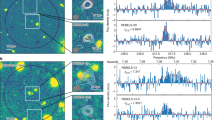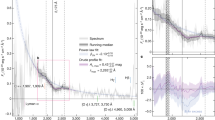Abstract
ELLIPTICAL galaxies are thought to have formed most of their stars in a rapid burst in the early Universe1, but an unambiguous example of a 'primaeval' elliptical galaxy (one undergoing its first major burst of star formation) has yet to be discovered. High-redshift radio galaxies are among the most promising candidates2'3, because their low-redshift counterparts are identified exclusively with ellipticals, but the presence of an active nucleus complicates the analysis of their evolutionary state from optical-infrared observations3"5. The failure of optical searches to detect primaeval ellipticals6"9 suggests that they may be very dusty, prompting us to search for thermal emission from the dust, which will be red-shifted to submillimetre wavelengths in our reference frame. Our detection of submillimetre emission from the radio galaxy 4C41.17, reported here, suggests that it contains a large mass of dust, probably located in a dust lane obscuring the centre of the galaxy10"14. The observations are consistent with the recent occurrence of a massive burst of star formation, but probably not the first such episode. We conclude that this galaxy was already in the final stages of its formation at a look-back time of 12-15 billion years.
This is a preview of subscription content, access via your institution
Access options
Subscribe to this journal
Receive 51 print issues and online access
$199.00 per year
only $3.90 per issue
Buy this article
- Purchase on Springer Link
- Instant access to full article PDF
Prices may be subject to local taxes which are calculated during checkout
Similar content being viewed by others
References
Sandage, A. Astr. Astrophys. 161, 89–101 (1986).
Eales, S., Rawlings, S., Puxley, P., Rocca-Volmerange, B. & Kuntz, K. Nature 363, 140–142 (1993).
Eales, S. A. & Rawlings, S. Astrophys. J. 411, 67–88 (1993).
Dunlop, J. S. & Peacock, J. A. Mon. Not. R. astr. Soc. 263, 936–966 (1993).
Tadhunter, C. N., Scarrott, S. M., Draper, P. & Rolph, C. Mon. Not. R. astr. Soc. 256, 53P–58P (1992).
Boughn, S. P., Saulson, P. R. & Uson, J. M. Astrophys. J. 301, 17–22 (1986).
Collins, C. A. & Joseph, R. D. Mon. Not. R. astr. Soc. 235, 209–220 (1988).
De Propris, R., Pritchet, C. J., Hartwick, F. D. A. & Hickson, P. Astr. J. 105, 1243–1250 (1993).
Thompson, D., Djorgovski, S. & Beckwith, S. V. W. Astrophys. J. (in the press).
Chambers, K. C., Miley, G. K. & van Breugel, W. Astrophys. J. 363, 21–39 (1990).
Miley, G. K., Chambers, K. C., van Breugel, W. & Maccherto, F. Astrophys. J. 401, L69–L73 (1992).
Carilli, C. L., Owen, F. & Harris, D. E. Astr. J. 107, 480–493 (1994).
Hippelein, H. & Meisenheimer, K. Nature 362, 224–226 (1993).
Graham, J. R. et al. Astrophys. J. 420, L5–L8 (1994).
Soifer, B. T., Houck, J. R. & Neugebauer, G. A. Rev. Astr. Astrophys. 25, 187–230 (1987).
Duncan, W. D., Robson, E. I., Ade, P. A. R., Griffen, M. J. & Sandell, G. Mon. Not. R. astr. Soc. 243, 126–132 (1990).
Rowan-Robinson, M. et al. Nature 351, 719–721 (1991).
Rowan-Robinson, M. et al. Mon. Not. R. astr. Soc. 261, 513–521 (1993).
Hughes, D. H., Robson, E. I., Dunlop, J. S. & Gear, W. K. Mon. Not. R. astr. Soc. 263, 607–618 (1993).
Chini, R., Kreysa, E. & Biermann, P. L. Astr. Astrophys. 219, 87–97 (1989).
Draine, B. T. & Lee, H. M. Astrophys. J. 285, 89–108 (1984).
Mathis, J. S. & Whiffen, G. Astrophys. J. 341, 808–822 (1989).
Knapp, G. R. & Patten, B. M. Astr. J. 101, 1609–1622 (1991).
Hines, D. C. & Wills, B. J. Astrophys. J. 415, 82–92 (1993).
Heckman, T. M., Chambers, K. C. & Postman, M. Astrophys. J. 391, 39–47 (1992).
Hughes, D. H., Gear, W. K. & Robson, E. I. Mon. Not. R. astr. Soc. 244, 759–766 (1990).
Owen, F. N. & Laing, R. A. Mon. Not. R. astr. Soc. 238, 357–378 (1989).
Solomon, P. M., Downes, D. & Radford, J. E. Astrophys. J. 398, L29–L32 (1992).
Author information
Authors and Affiliations
Rights and permissions
About this article
Cite this article
Dunlop, J., Hughes, D., Rawlings, S. et al. Detection of a large mass of dust in a radio galaxy at redshift z = 3.8. Nature 370, 347–349 (1994). https://doi.org/10.1038/370347a0
Received:
Accepted:
Issue Date:
DOI: https://doi.org/10.1038/370347a0
This article is cited by
-
Distant radio galaxies and their environments
The Astronomy and Astrophysics Review (2008)
-
The formation of cluster elliptical galaxies as revealed by extensive star formation
Nature (2003)
-
High-redshift star formation in the Hubble Deep Field revealed by a submillimetre-wavelength survey
Nature (1998)
Comments
By submitting a comment you agree to abide by our Terms and Community Guidelines. If you find something abusive or that does not comply with our terms or guidelines please flag it as inappropriate.



